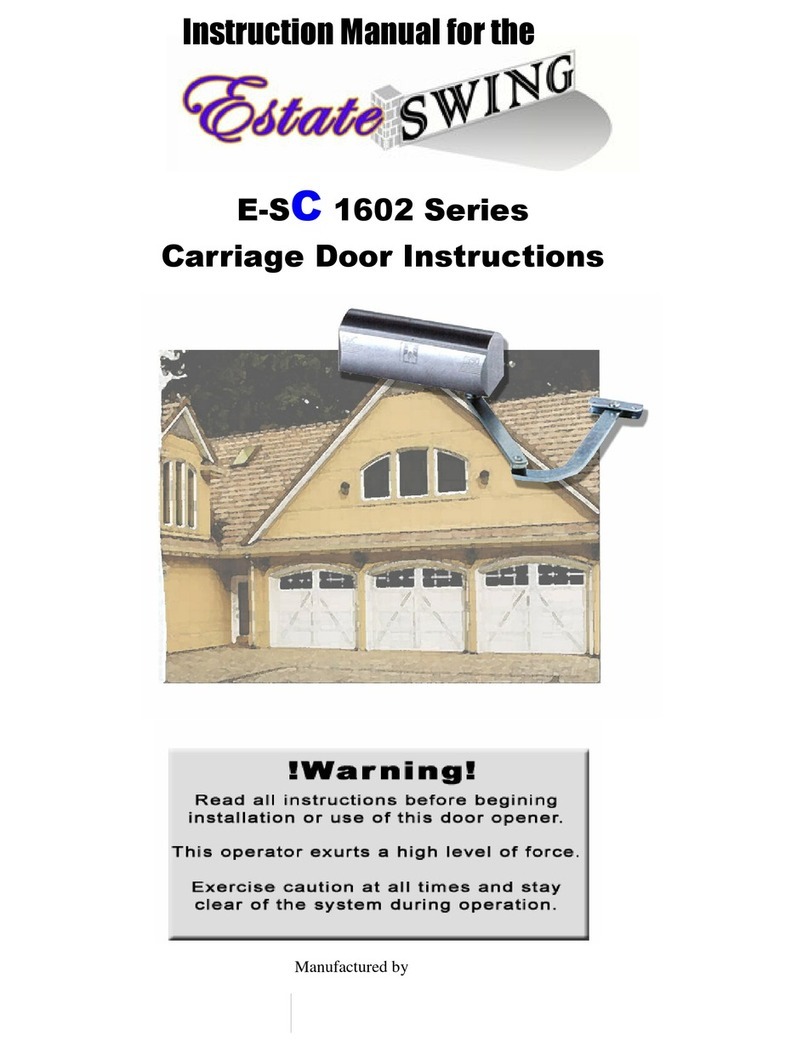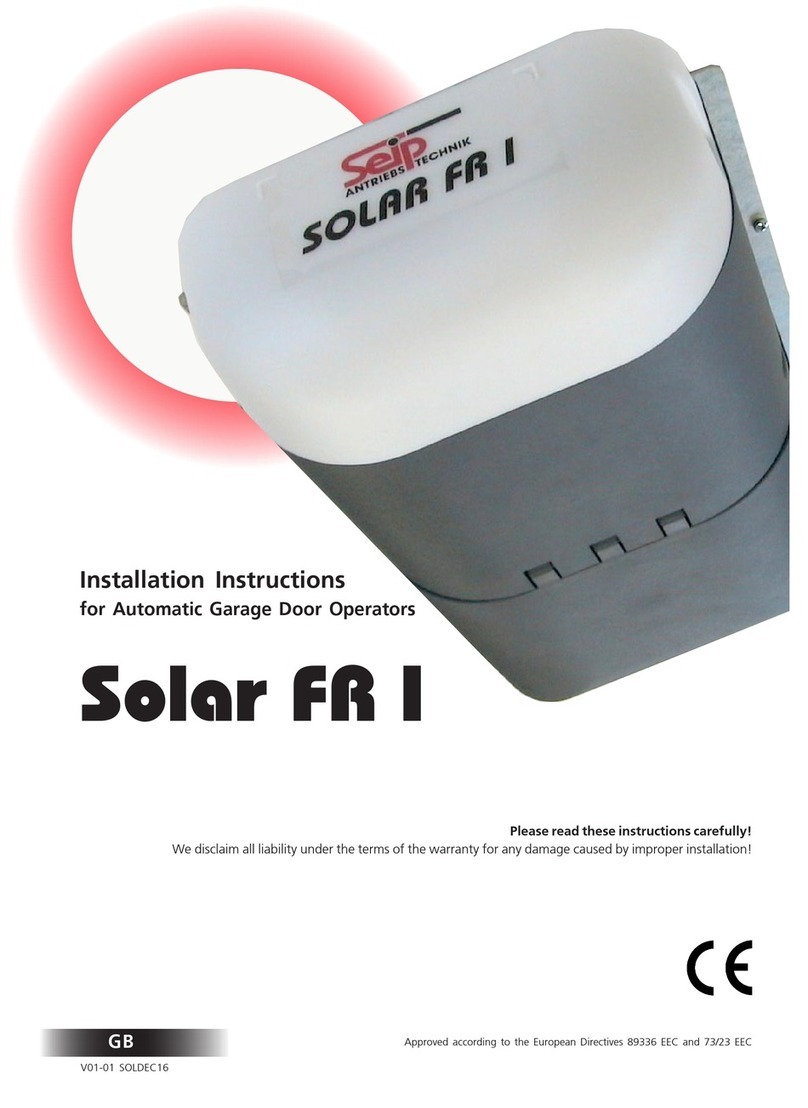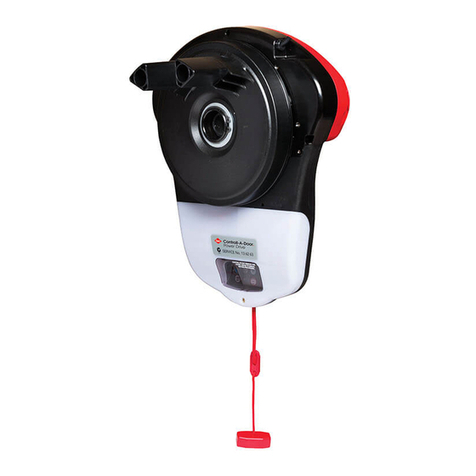B&B ARMR 4X0E Series User manual

MODEL 4X0E SERIES
SLIDING GATE
VEHICLE BARRIER
INSTALLATION MANUAL
B&B ARMR
Headquarters & Tech Support:
5900 S Lake Forest Dr Suite 230
McKinney, TX 75070
Phone: (800) 367-0387
Fax: (972) 385-9887
E-mail: [email protected]
www.bb-armr.com
MADE IN THE USA

Installation and Operations Manual —Model 400E Series iv
B&B ARMR
A Division of B&B Roadway and Security Solutions 0400E-9001 Rev J
INTRODUCTION
Welcome!
Congratulations on your purchase of a B&B ARMR vehicle barrier. In addition to
providing detailed operating instructions, this manual describes how to install, maintain,
and troubleshoot your vehicle barrier. If you require additional assistance with any
aspect of your vehicle barrier's installation or operation, please contact us.
With years of experience in all aspects of perimeter security and related disciplines, our
products are used throughout the world to control access and to protect people,
equipment, and facilities. We offer a broad range of vehicle barrier and related security
services:
Routine barrier preventative maintenance or emergency repairs (including
work on non-B&B ARMR products)
Spare or replacement parts
Custom designs or special installations
Equipment upgrades (modernize your old equipment with state-of-the-art
systems)
Technical support via telephone and possible on site support with
advanced scheduling.
Safety
Your safety is important to us. If you have any questions or are in doubt about any aspect of
the equipment, please contact us. While B&B ARMR does not assume responsibility for
injury to persons or property during installation, operation, or maintenance, we can provide
verbal guidance, additional written instructions, or the services of a factory engineer. We're
here to help you operate your vehicle barrier safely and effectively.
As the user, you are responsible for correct and safe installation, operation, and maintenance
of this equipment. Users must follow the specific instructions and safety precautions located
in this manual. In addition they must:
Be aware of and follow the safety standards of the Occupational Safety and
Health Administration (OSHA), as well as other applicable federal, state, and
local safety regulations and industry standards and procedures. For installation
outside the United States, users must also follow applicable international,
regional, and local safety standards.
Your safety is extremely important to us. If you have any
questions or are in doubt about any aspect of the equipment,
please contact us.

Installation and Operations Manual —Model 400E Series v
B&B ARMR
A Division of B&B Roadway and Security Solutions 0400E-9001 Rev J
Engage only trained and experienced staff to install, operate, and maintain the
equipment.
Ensure that all repairs are performed correctly, using properly trained staff and
the right tools and equipment.
How to Contact Us
If you have any questions or experience any problems with your vehicle barrier—or if we
can help you with any other facility security issues—please contact us directly at:
HQ/Tech Support:
B&B ARMR
5900 S Lake Forest Dr Suite 230
McKinney, TX 75070
Phone: (800) 367-0387
Fax: (972) 385-9887
E-mail: [email protected]
System Installation Record
To assist in documenting the products installed in your system, please take a minute to
record the following reference information. This information can be located on the blue
B&B ARMR model number plate located on the product in the cylinder access area.
Site:
Job #:
Date:
Serial Number:
Model Number:
Voltage/Phase:

Installation and Operations Manual —Model 400E Series vi
B&B ARMR
A Division of B&B Roadway and Security Solutions 0400E-9001 Rev J
Table of Contents
INTRODUCTION......................................................................................................................................... iv
Welcome! .................................................................................................................................................iv
Safety........................................................................................................................................................iv
How to Contact Us...................................................................................................................................v
System Installation Record.....................................................................................................................v
1. ORIENTATION....................................................................................................................................... 6
1.1 Overview .......................................................................................................................................... 6
2. INSTALLATION...................................................................................................................................... 9
2.1 Preliminary Considerations............................................................................................................. 9
2.2 Typical Installation of the Main and Receiver Stanchions..............................................................10
2.4 Installing the Gate and Motor Components....................................................................................11
2.5 Control System Installation.............................................................................................................12
3.4 Operational Test..............................................................................................................................15
3.5 ECO Operation ...............................................................................................................................15
3.6 Barrier Operation during a Power Outage.....................................................................................15
3.7 Barrier Operation during a Power Outage –With Optional Manual Drive System.......................15
5. TROUBLESHOOTING ...........................................................................................................................19
6. REFERENCE DRAWINGS.....................................................................................................................20
7. WARRANTY............................................................................................................................................26
1.ORIENTATION
1.1 Overview
This manual addresses B&B ARMR’s Model 400/450 Electric Drive Cantilever Gates.
Barrier
Model
Vehicle Weight
Vehicle Speed
U.S. Department of
State Rating*
400 & 400A
15,000 pounds
(~6,800 kg)
30 mph
(~48 kph)
K4
450 & 450A
15,000 pounds
(~6,800 kg)
50 mph
(~80 kph)
K12
The gate speed is factory set at approximately one foot per second.

Installation and Operations Manual —Model 400E Series 7
B&B ARMR
A Division of B&B Roadway and Security Solutions 0400E-9001 Rev J
Manual operation of the gate can be performed by lowering drive assembly,
disengaging actuator from lock pins (Model 450 Only) and manually pushing the
gate. An optional manual over ride system can be purchased at the time of order
to allow gate opening and closing without disengaging drive assembly.
Motor controller ramps up and down the movement of the gate to reduce wear and
shock on drive unit based on limit switch trip plate locations.
Minimal wiring, no hydraulic hoses to pull.
1.1.1 Gate Leaf
The gate leaf pickets are typically 1" square steel tubes spaced on 2.5" centers. The
standard gate height is 108 inches (9 feet or 2.75 meters) above grade but custom sizes
are available.
Figure 1 Model 400 Cantilever Gate

Installation and Operations Manual —Model 400E Series 8
B&B ARMR
A Division of B&B Roadway and Security Solutions 0400E-9001 Rev J
1.1.2 Drive Stanchion
The drive stanchion supports the gate with the four main drive wheels and allows the
drive unit to mesh with the rack located on the underside of the gate beam.
Figure 2 Model 4x0E Drive Stanchion
Figure 3 Drive Unit

Installation and Operations Manual —Model 400E Series 9
B&B ARMR
A Division of B&B Roadway and Security Solutions 0400E-9001 Rev J
1.1.3 Receiver Stanchion
The receiver stanchion captures (and locks in model 450) the end of the gate when the gate is
fully closed.
The Model 450 has a pair of two inch diameter stainless steel pins that are electrically
actuated to lock the gate closed. Limit switches indicate the location of the lock pins. The
actuator motor (2 wires) and its two limit switches (2 wires each) may share a ¾”conduit to
the electrical enclosure.
Figure 4 Lock pin Assembly (Model 450)
2. INSTALLATION
Your safety is extremely important to us. Be sure to
follow all instructions. You are responsible for the
correct and safe installation, operation, and
maintenance of this equipment.
2.1 Preliminary Considerations
Before beginning site excavation and barrier installation:

Installation and Operations Manual —Model 400E Series 10
B&B ARMR
A Division of B&B Roadway and Security Solutions 0400E-9001 Rev J
1. Inspect the site and verify there are no underground utilities or overhead
wires or obstructions in the excavation area.
2. Make sure that there is adequate free area adjacent to the motor stanchion's
installation location so that the vehicle barrier gate can be slid onto the
stanchion after the stanchion is cemented in place.
2.2 Typical Installation of the Main and Receiver Stanchions
Perform the following steps to install the main and receiver stanchions. (Always refer to your
submittal for your specifications.)
2.2.1 Excavate the holes for the stanchions as shown in the Foundation Drawings
supplied in your submittal. (See drawings section). Place the stanchions in
the excavation holes. A partial pour or concrete footing, is acceptable to
assist in location.
2.2.2 Install the axles for the roller wheels in the appropriate holes (if not
previously installed) in the stanchions and tighten the setscrews against the
flats on the axles. Tighten the setscrews securely, and use a locking
compound on the setscrews threads if available.
NOTE: It is critical that the axle nuts are secure prior to the gate beam
installation.
2.2.3 The center of the axles must be 31-¾ inches above the roadbed height at the
roadbed's highest point. If wheels are factory installed make sure the tops of
the wheels are 35-¾ inches above the roadbed. Adjust the stanchion's
position in the excavation to bring the axles to the correct height. Use a
transit to level all four points (the top of the end of each axle or wheel) and
make any final adjustments in the positions of the stanchions so that the
transit is reading within 1/32nd of an inch at each of the four points. It is
CRITICAL THAT THE SHAFTS ARE LEVEL for the gate to function
properly. Verify also that the stanchions are plumb and level. Verify drive
stanchion is also aligned to where the receiver stanchion shall be located.
Use the center of the axles as a reference to align the receiver stanchion.
2.2.4 Ensure all required conduits are in place. Conduits may be required for
traffic lights, loop detectors, and other options. The project submittal may
provide detail as to the final conduit requirements for your installation.
2.2.5 Place a partial pour of concrete into the excavation holes to lock the
stanchions in place. Use a transit to verify the stanchions remain level and
plumb.
2.2.6 Rough in the conduits. All conduits, fittings, sweeps, and couplings must be
electrical grade (gray color); do not use plumbing type (white color). All
conduits are run to the control unit.

Installation and Operations Manual —Model 400E Series 11
B&B ARMR
A Division of B&B Roadway and Security Solutions 0400E-9001 Rev J
2.2.7 Make the final concrete pour, again making sure the axle height does not
change and remain level and plumb. Remove any concrete that might have
splattered inside the exposed conduits.
2.2.8 After the concrete has set, install the roller wheels, collars and nuts onto the
axles if not previously installed. Place two collars (spacers) on each side of
the shaft, then the wheel, then another collar, and finally the nut. Adjust the
wheels and axle nuts so there is no side play in the wheels, but yet they can
still be turned easily by hand. Tighten set screw on the nut. Grease the wheel
bearings using the grease fittings. The wheels may be pre-greased. Be
careful not to over-grease the bearings.
NOTE: It is critical that the axle nuts are secure prior to the gate beam
installation.
2.2.9 Install the four guide wheels into the guide wheel receivers on the wheel
stanchion. Leave the bolts fully backed off to allow the guide wheels to
insert completely into the receivers.
2.4 Installing the Gate and Motor Components
Perform the following steps to install the gate (gate leaf), motor, and limit switches on the
motor/main stanchion.
2.4.1 Lift the gate assembly using a crane or forklift. Guide the gate onto the first
set of roller wheels, with the wheels fitting between the I-beam and the
channel. Push the gate onto the second set of roller wheels.
2.4.2 Move the gate by hand to the halfway position. Install the end plates and
rubber stops onto the ends of the gate.
2.4.3 Slide the gate through about ⅔ of its travel. If the gate binds, adjust the guide
roller wheels to eliminate the binding.
2.4.4 Mount the motor and gear assembly. Mount the motor on the wheel post
closest to the roadway opening and on the side between the two single posts.
Leave the motor mount in the down position with the bolts slightly loose
until the motor rotation and limit switches have been tested.
2.4.5 Mount the limit switches.

Installation and Operations Manual —Model 400E Series 12
B&B ARMR
A Division of B&B Roadway and Security Solutions 0400E-9001 Rev J
Figure 5 Limit Switch Mounting
2.4.6 Bolt the limit switch plates so they engage the limit switches' lever arms. The
plate must be located so that both limit switches are hit in the correct
sequence. The first limit switch tells the controller to slow the gate down.
The second limit tells the controller to stop the gate.
2.4.7 Grease or cosmoline needs to be added to the rack, pinion and wheel areas to
prevent oxidation. This should be checked and touched up during the
monthly maintenance as needed.
2.4.8 Grease the pillow block bearings on the motor assembly.
2.5 Control System Installation
The electrical control enclosure is mounted on the main stanchion.
2.5.1 Install power wires to breaker inside external enclosure mounted to control box.
NOTE: The auxiliary receptacle inside the electrical control box is not to be wired
from the 120VAC inside the cabinet. This supply shall be a separate incoming
supply 120VAC circuit only. Using power from the electrical cabinet for this
receptacle may void all warranty for the product.
2.5.2 Terminate all 24VDC input devices between the red 24VDC terminal blocks and
the associated input.
2.5.3 Terminate all field control wiring to appropriate terminal blocks. All inputs are
normally open except for the STOP input. Each device shall have 2 wires. One wire
terminates into a red 24VDC terminal block, the other to the associated terminal block
marked with that input number.

Installation and Operations Manual —Model 400E Series 13
B&B ARMR
A Division of B&B Roadway and Security Solutions 0400E-9001 Rev J
Description
Terminal
Block
OPEN
I1
CLOSE
I2
LOCK PIN UP (450)
I3
CLOSED LIMIT A
I4
OPEN LIMIT A
I5
SAFETY DEVICES (ALL)
I6
STOP (NORMALLY CLOSED)
I7
ECO
I9
ECO RESET
I10
CLOSED LIMIT B
I11
OPEN LIMIT B
I12
LOCK PIN DOWN (450)
I13
BACK SENSOR
I14
2.5.4 Terminate field output wiring for optional components.
Traffic Lights
Terminal Block
Common
120VAC Neutral (white
terminal blocks)
GREEN/AMBER
Q6
RED
Q7
Control Panel Indicators
Terminal Block
0V
0V (black terminal blocks)
GREEN INDICATOR
Q8
RED INDICATOR
Q9
ECO
Q10
OPTIONAL DEVICES
Loop Detector –One loop detector and socket come pre-wired for use as a safety. The
loop wires connect to terminals 7 & 8 on the loop detector socket. The safety loop is
wired into the safety input in the ECU.
IR Beam –It is suggested that infrared safety beams are used as an additional layer of
safety. An IR beam receiver’s Normally Open output may be wired into the safety input
in the ECU.
Edge Detector –A closing edge detector’s receiver may be wired into the safety input in
the ECU, and an optional opening edge detector’s receiver may be wired into the
Backsensor input in the ECU.
Card Reader –A 3rd party entry access device such as a badge reader may be used to
open the gate. A normally open output on such a device may be wired to the open input
in the ECU.

Installation and Operations Manual —Model 400E Series 14
B&B ARMR
A Division of B&B Roadway and Security Solutions 0400E-9001 Rev J
3.3.4 Test CLOSE operation: Verify gate is positioned between limit switches and does not
block locking pins (Model 450 only). Give the gate a CLOSE command and verify that the
pinion turns in the direction that would move the gate towards the receiver stanchion.
Manually trip CLOSE LIMIT A and verify the motor begins to slow. Manually trip CLOSE
LIMIT B and verify motor stops. Verify the locking pin actuator (Model 450) lowers the
locking pins until the LOCK PIN DOWN input comes on and the actuator stops.
3.3.5 Test OPEN operation: Give the gate an OPEN command. Verify the locking pins raise
and the LOCK PIN UP input is activated. Verify the motor rotates correctly to move the gate
in the open direction. Manually trip the first limit switch and verify the OPEN LIMIT A
PLC input activates and the motor begins the slow. Manually trip the second limit and verify
the OPEN LIMIT B activates. Verify the motor stops.
The Model 450 system is designed with a software parameter (LPMRT) to limit the actuator
run time in case of malfunction and the LOCK PIN DOWN input does not activate. The
default value is 8 seconds. During a malfunction the lock pins will reverse to a retracted
position and the RED INDICATOR output will flash rapidly. Investigation and adjustment
of the trip plates and beam should be made to ensure the pins engage in the slots in the beam.
To clear the alarm the CLOSE command can be re-issued.
3.3.6 Set the motor mount: With the gate in a half open position, and the spring on the
motor drive assembly is in the factory compressed state, raise the assembly into the rack until
the pinion gear meshes with the rack 80%. Move the gate to the open position, and observe
the spacing between the pinion gear and rack. Move the gate to the closed position and
observe the spacing. Using the vertical motor adjustments move the drive system until the
spacing between the rack and pinion is engaged at least 80% for both fully open and fully
closed. The spring system may compress if required to meet the 80% minimum requirement.
3.3.7 Install Safety stop rubber pads: With the stop plate off, install the rubber pads on the
inside bottom lip of the gate beam. Place the end plate back on and tighten the bottom bolts
first. Tighten top bolts last to ensure rubber pad is fully secured. If required both rubber
pads can be placed on one side of the beam.
Before engaging the pinion with the rack, verify that the limit
switches are mounted and wired correctly. Failure to do so
could cause severe damage or injury.

Installation and Operations Manual —Model 400E Series 15
B&B ARMR
A Division of B&B Roadway and Security Solutions 0400E-9001 Rev J
Figure 6 End Plates
3.4 Operational Test
3.4.1 Give the gate an OPEN command. The locking pin will raise (Model 450), and the
motor will accelerate and run to move the gate open. The first limit switch will begin the
speed reduction of the motor. The second limit switch will stop the motor. If Model 400, the
gate will move immediately upon receiving the open command.
3.4.2 Give the gate a CLOSE command. The motor will accelerate and run to move the gate.
The first close limit switch will begin the speed reduction of the motor to the second close
limit switch will stop the motor. Once the second close limit switch is tripped, the lock pin
will engage (Model 450).
3.4.3 Verify that there are no interferences between the moving parts and that the limit
switches are hitting the trip plates correctly. Make any necessary adjustments.
3.4.4 Verify the operation of the gate is smooth for the entire travel length.
3.5 ECO Operation
Emergency Close Operation (ECO) command acts identically to a CLOSE command
except all safety inputs are ignored. It should only be used during an emergency. An
ECO RESET must be issued after any ECO command before the gate will respond to an
open command.
3.6 Barrier Operation during a Power Outage
Disconnect the locking pin actuator from the locking pins and swing actuator out of the
way to manually lift the locking pins (Model 450). Disengage and lower the motor drive
assembly and manually open the gate.
3.7 Barrier Operation during a Power Outage –With Optional Manual Drive System

Installation and Operations Manual —Model 400E Series 16
B&B ARMR
A Division of B&B Roadway and Security Solutions 0400E-9001 Rev J
If the system you are operating is equipped with the manual override drive system the
following is done to move the gate.
Your safety is extremely important to us. Be sure to
follow all instructions. You are responsible for the
correct and safe installation, operation, and
maintenance of this equipment.
Tools needed:
1. Manual Override Tool (supplied with original 450E equipment)
2. Fully charged, battery operated cordless drill
3. Access keys/codes to Receiver Stanchion, Locking Pin Access Door
Receiver Stanchion Crash Pin Release
1. Open Crash Pin locking equipment access door (1) located on the top of the
Receiver Stanchion assembly.
2. Use a tool or block (2) placed under the Locking Pin Plate (3) and then impress
the button on the Pull Pin (4) to remove (this releases the electrical drive assembly from
the Locking Pin assembly).
3. Raise the Locking Pin Plate assembly (3) approximately 15 cm (6 inches) and
place the Pull Pin (4) in the hole located in the vertical weldment plate (5) to hole the
Locking pins above the moving gate assembly.
4. Allow the Locking Pin Plate to rest on the Pull Pin.
5. Proceed to the Drive Stanchion Manual Drive Procedure.

Installation and Operations Manual —Model 400E Series 17
B&B ARMR
A Division of B&B Roadway and Security Solutions 0400E-9001 Rev J

Installation and Operations Manual —Model 400E Series 18
B&B ARMR
A Division of B&B Roadway and Security Solutions 0400E-9001 Rev J
Drive Stanchion Manual Drive Procedure
Serious injury may occur if electrical power resumes during this
procedure.
Do not alter or defeat safety Proximity Lockout Sensor (6). The Proximity
Lockout Sensor is design to prevent accidental operation of the motor if
power resumes during the use of the Manual Override Tool.
Do not position any part of your body in the pathway of moving.
1. Locate the electric Drive Motor underneath the 450E Gate Drive Beam (7).
2. Load the Manual Override Tool (8) into the cordless drill and align tool over the
Motor Shaft (9), located inside the large of the Motor Shroud (10)
3. Assure that the Manual Override Tool is consistently engaged with the Motor
Shaft and operate the drill for several minutes until Gate is in the desired position.

Installation and Operations Manual —Model 400E Series 19
B&B ARMR
A Division of B&B Roadway and Security Solutions 0400E-9001 Rev J
5. TROUBLESHOOTING
The table below provides guidance on identifying and correcting issues with your Model 400
Series vehicle barrier. If you encounter problems that you cannot fix, contact B&B ARMR
and we will gladly work with you to correct them.
Model 4x0E Troubleshooting Guide
Symptom
Actions
Gate does not open or close
1. Check power, fuses
2. Check Limit Switches
3. Check PLC inputs
4. Check PLC outputs
5. Check that safeties are clear
6. Check push button operation
7. Check locking pin and limit switch,
gate will not open unless the pins are up
and LOCK PIN UP input is activated on
the PLC.
8. Manually open the gate by to see if
the problem is mechanical or
electrical. If mechanical,
check for binding on the gate.
Gate makes noise during operation
1. Check that roller wheel bearings are
greased
2. Check that gate is not moving too fast
3. Check that the guide wheels are properly
adjusted
4. Check that the spur gear is properly
adjusted to the gear rack
Gate moves too slowly
1. Check for mechanical binds (guide wheels
out of adjustment, debris under the wheels
or on the inside of gate
Traffic indicator light does not change
1. Check proper limit switch operation
2. Check bulbs
3. Check PLC outputs
Locking pins are moving but not giving
signals up or down to I3
1. Check the limit switches at the
locking pin mechanism
After any major repairs, review the installation setup
instructions before returning the barrier to service

Installation and Operations Manual —Model 400E Series 20
B&B ARMR
A Division of B&B Roadway and Security Solutions 0400E-9001 Rev J
6. REFERENCE DRAWINGS
The following drawings are provided for reference only. For job specific drawings and
details please refer to the Submittal Documentation specific to the job.
For replacement components and parts breakdown, please contact B&B ARMR tech
support.

Installation and Operations Manual —Model 400E Series 21
B&B ARMR
A Division of B&B Roadway and Security Solutions 0400E-9001 Rev J
B&B ARMR
2009 Chenault Dr. #114
Carrollton, Tx 75006
800-367-0387
GENERIC
400 CANTILEVER SLIDING GATE
20' RIGHT HAND CLEAR OPENING
9' GATE HEIGHT

Installation and Operations Manual —Model 400E Series 22
B&B ARMR
A Division of B&B Roadway and Security Solutions 0400E-9001 Rev J
B&B ARMR
2009 Chenault Dr. #114
Carrollton, Tx 75006
800-367-0387
400 CRASH BEAM
LEFT HAND CLEAR OPENING
This manual suits for next models
4
Table of contents
Popular Garage Door Opener manuals by other brands
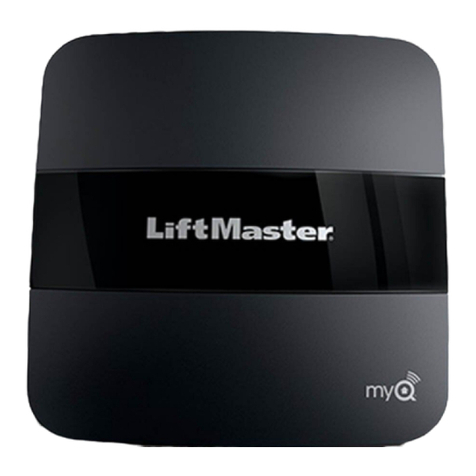
Chamberlain
Chamberlain MYQ-G0303-SP quick start guide
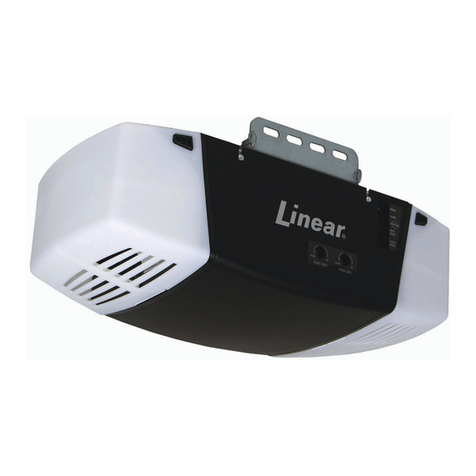
Linear
Linear LCO75 installation instructions
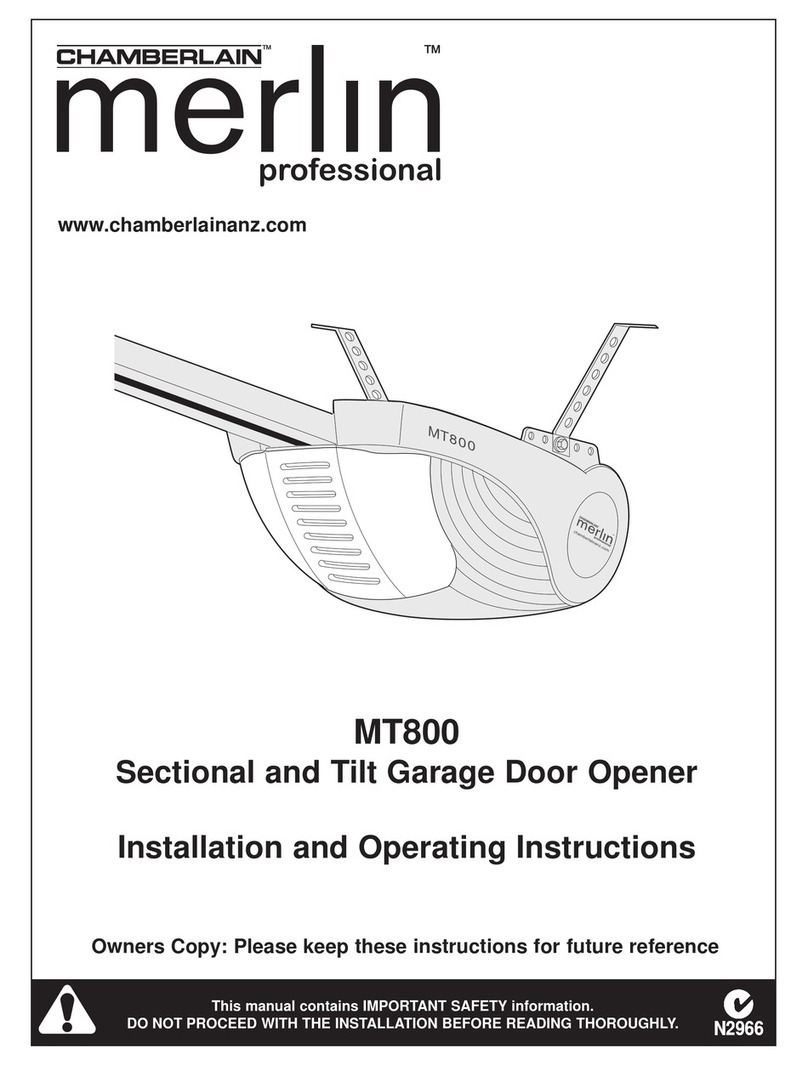
Chamberlain
Chamberlain Merlin MT800 Installation and operating instructions

Automatic Technology
Automatic Technology HiRO GDO-12 installation manual
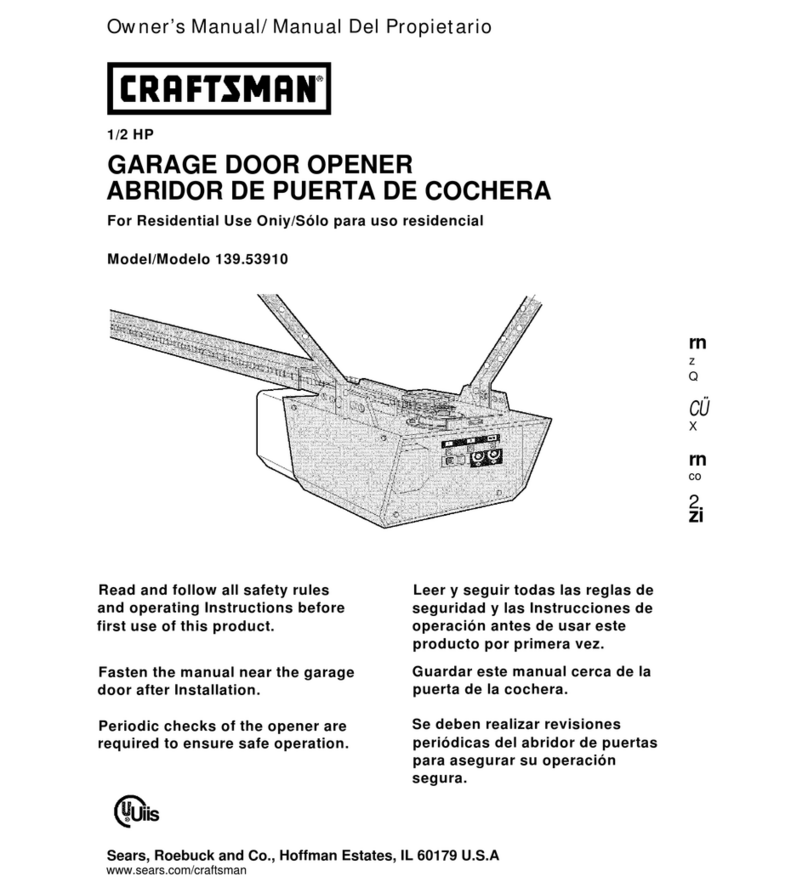
Sears
Sears Craftsman 139.53910 owner's manual
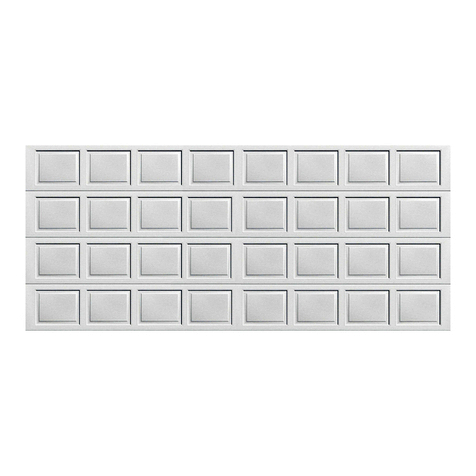
Wayne-Dalton
Wayne-Dalton 9100 installation manual
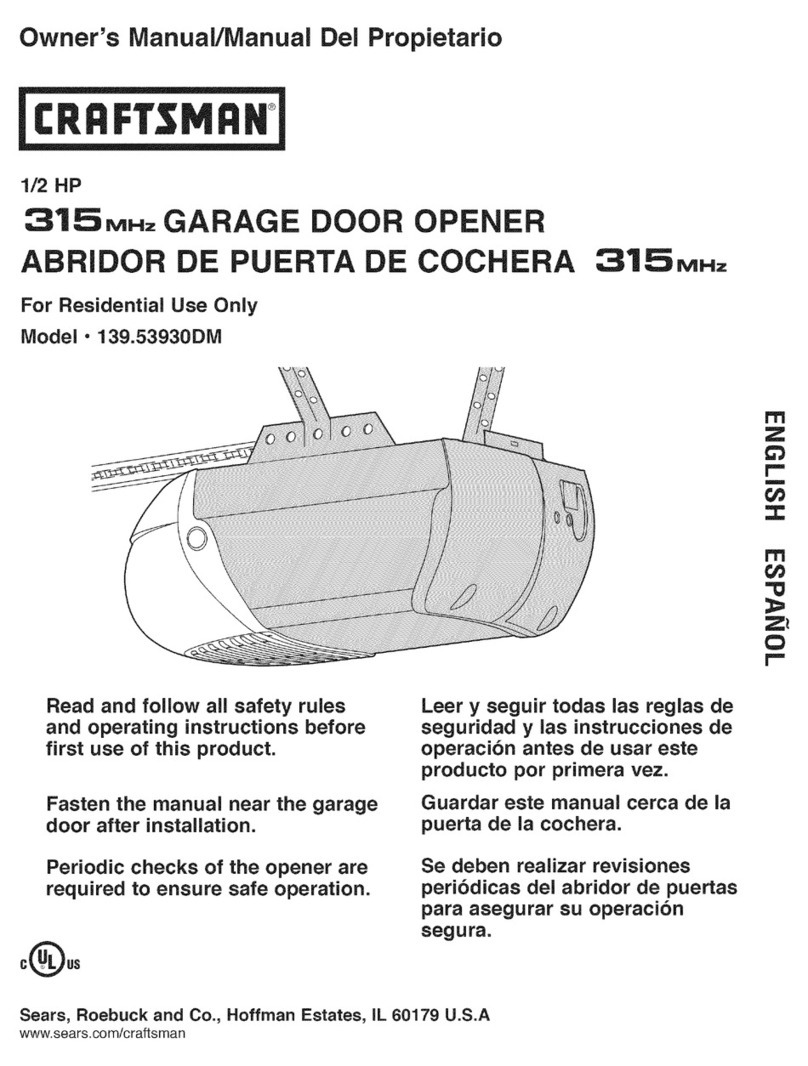
Craftsman
Craftsman 139.53930DM owner's manual
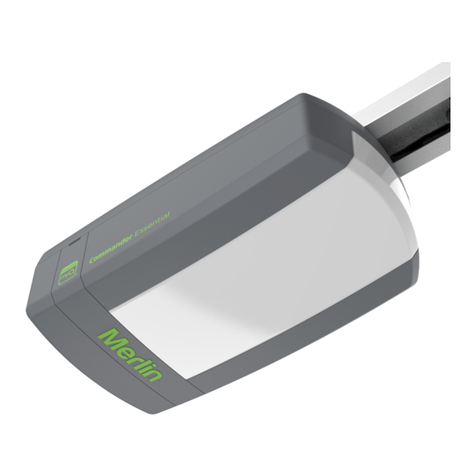
Merlin
Merlin MS65MYQ Installation and operating instructions

SkyLink
SkyLink ATOMS Series owner's manual
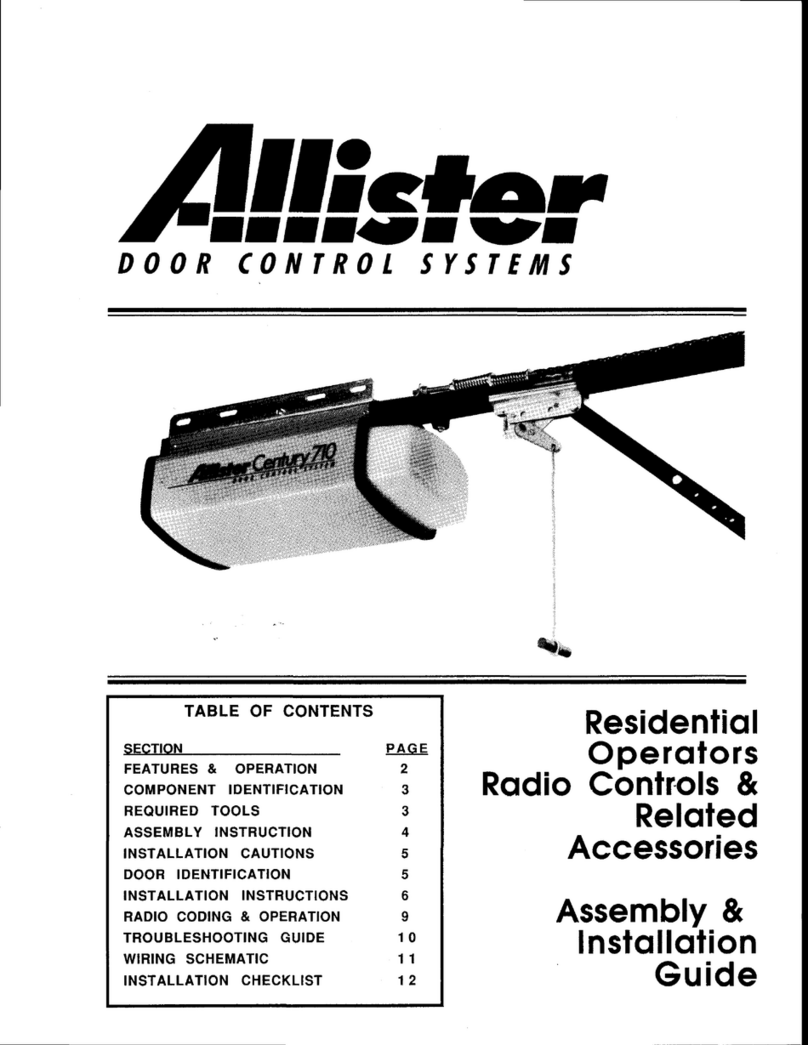
Allister
Allister Century 310 Assembly & installation manual

Abloy
Abloy DA460 Installation and commissioning manual

Chamberlain
Chamberlain MT5011U installation manual
